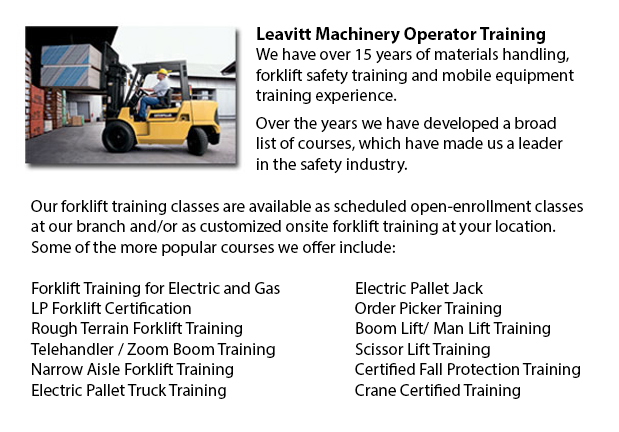
Markham Forklift Training Schools - Have An Efficient And Safe Work Place With Our Forklift Training Schools
Are you looking for a job as a forklift driver? Our regulatory-compliant mobile equipment operator training provides instruction in types of lift trucks, pre-shift check, fuel kinds and handling of fuels, and safe operation of a lift truck. Practical, hands-on training assists participants in acquiring essential operational skills. Program content covers current rules governing the utilization of forklifts. Our proven forklift courses are meant to offer training on these types of trucks: counterbalanced forklift, powered pallet trucks and narrow isle forklift.
Do not raise or lower the fork when the lift truck is traveling. A load should not extend over the backrest due to the possibility of the load sliding back toward the operator. Check for overhead obstacles and ensure there is adequate clearance prior to lifting a load. Stay away from overhead power lines. Once the load is raised straight up, tilt it slightly back.
While the load is lifted the forklift will be less stable. Make certain that no pedestrians cross under the elevated fork. The operator should never leave the lift truck when the load is lifted.
While handling pallets, forks should be level and high enough to go into the pallet and extend all the way underneath the load. The fork's width should provide even distribution of weight.
Set the brakes and chock the wheels before loading and unloading the truck. The floors must be strong enough to support the combined weight of the load and the forklift. Fixed jacks could be installed to support a semi-trailer that is not coupled to a tractor. The height of the entrance door should clear the height of the forklift by at least 5 cm. Edges of docks, rail cars and ramps must be marked and avoid them.
-
Markham Forklift Certification Schools
Markham Forklift Certification Schools - Forklift Certification is mandatory in North America. Hence, forklift training programs are essential both for businesses and for people seeking jobs in industries as forklift operators. Forklift training focu... More -
Telehandler Training in Markham
Telescopic handlers normally called telehandlers for short, are a very popular piece of heavy construction equipment. They are commonly utilized in the construction and agricultural trades. These machines have maximum reaching capability and can get... More -
Markham Zoom Boom Training
Markham Zoom Boom Training - Zoom Boom Training is designed to train operators on variable reach forklifts. The objectives of the training are to impart an understanding of the physics of the machinery, and to outline the operator's tasks. This progr... More -
Markham Heavy Equipment Ticket
Markham Heavy Equipment Ticket - A heavy equipment operator will utilize different construction machinery, depending upon the nature of the task at hand. The large equipment are constructed to carry out specific tasks in the most efficient method for... More -
Markham Scissor Lift Training
Markham Scissor Lift Training - When operating a scissor lift, they must be utilized competently so as to protect the safety of the other employees inside the workplace and to protect the safety of the machine. Competent operators are trained to driv... More -
Markham Manlift Operator Training
Markham Manlift Operator Training - The aerial lift or manlift is a specialized kind of hydraulic platform which is designed to raise a person vertically giving it an alternate name of a vertical personnel lift. These machines are widely used for a m... More -
Markham Heavy Equipment Training
Markham Heavy Equipment Training - The two most common kinds of heavy equipment training are classed into the categories of machinery; equipment that is fashioned with tracks and those with rubber tires. The tracked vehicle are heavy duty equipment s... More -
Markham Forklift Safety Training
Markham Forklift Safety Training - Those wanting work in industries that utilize forklifts should undergo a forklift safety training course before becoming a certified operator of a forklift. There are various ways to go about getting forklift safety... More

Forklift Certification Markham
TOLL FREE: 1-888-254-6157
Markham, Ontario
forkliftcertificationmarkham.com
Email Us
About Us


